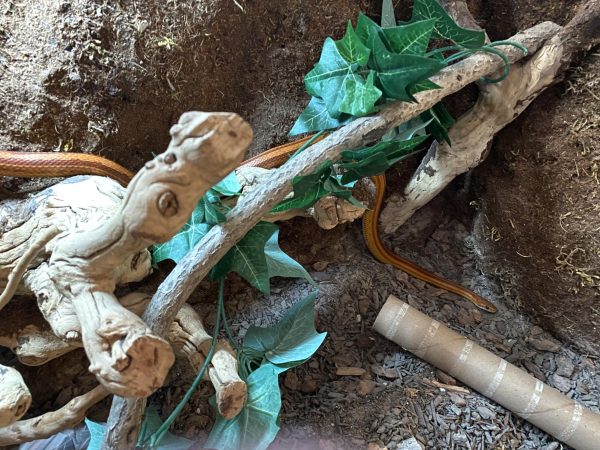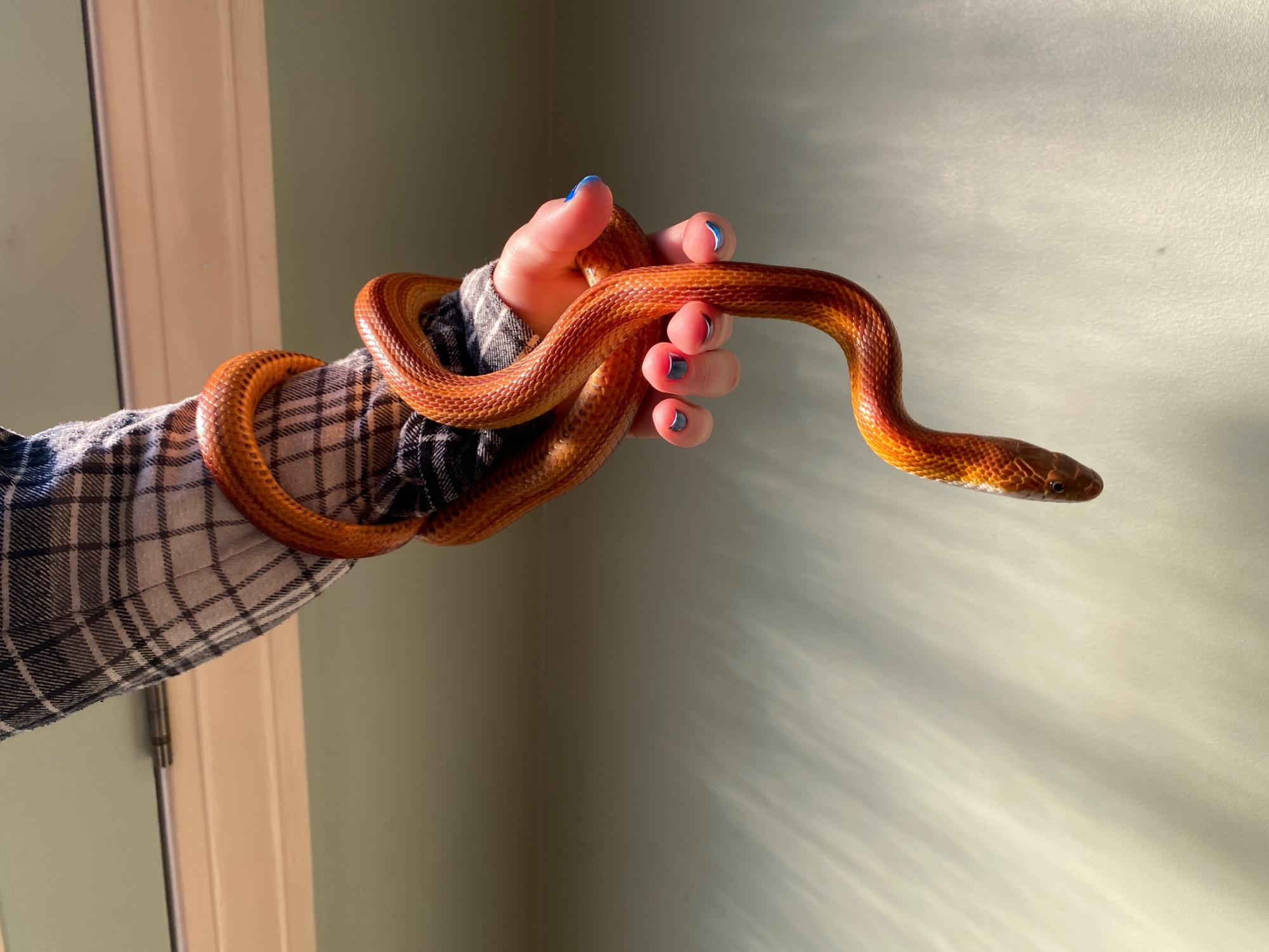Snakes: These scaly reptiles can be either the object of vilification or admiration, depending on who you ask. Increasingly, they’ve slithered into hearts as beloved pets. Today, nearly 800,000 Americans own a snake, according to the National Pet Ownership Survey. They’ve even sneaked onto social media, dressed in long fluffy sweaters and funny hats. More and more people are seeing the potential of snakes as pets.
But how does a prospective snake keeper know they’re ready? Five years ago, I got my own corn snake, who I named Amaterasu after the Shinto Sun Goddess. Along the way, some unexpected realities of snake keeping have come to light. Here are some overlooked aspects young keepers should know before they get a snake.
Acceptance of Pet Snakes
Of all the creatures in the world, snakes are among the most maligned. “Serpents”, reminiscent of the disguise of biblical Lucifer, are what my great aunt calls them. Unfortunately for many young keepers, parents often have the same attitude.
Still, it’s necessary for them to get their parents’ permission to own a snake. After all, it’s unfair to the snake to keep it in a tenuous situation of secrecy. But, with some convincing, disapproving parents can be turned around!
Identify their hang ups and address them. Are they scared? Show them the beauty and benefits of snakes.
Are they afraid the snake will bite? Prove to them that many pet snakes rarely bite– by taking them to an educational reptile show!
Are they worried the snake will be abandoned? Show your responsible nature and develop a lifetime plan for the snake.
Keep the tone persuasive, but not pushy. My parents weren’t always onboard, until I wrote a persuasive essay convincing them. Above all, respect a no. You have an entire adulthood ahead to get a snake.
Parents aren’t the only barrier created by snake stigma. Will people in the future approve of a snake? This could be friends, roommates, relatives, partners, even landlords. When my grandma visits, I have to hide the frozen rodents deep in the freezer. No mentions of Amaterasu are to occur!
I even know someone who lost a friend because their friend’s parents were uncomfortable with them owning a snake.
Not all housing is tolerant of snakes. Policies can vary between landlord to landlord, with some prohibiting snakes entirely and some requiring large deposits. For students, the most common obstacle is college. Most colleges prohibit snakes in the dorms and many colleges require freshmen to live on-campus.
Local laws can change with little notice; a new Florida rule on green iguanas and tegus led to some giving up their pets or leaving the state. Consider if your future path is suitable for snakes. Will you have choice of pet-friendly housing? Does your dream college allow snakes? How many cities allow your species of choice? If you’re uncertain, keep in mind it may be easier to wait than end up with you and your snake in a precarious situation.
Finding the Appropriate Location
The snake’s enclosure needs to go somewhere, and that somewhere has parameters. I chose to house my snake in my bedroom, but not everyone is fine hearing snake farts at midnight!
First, snakes are sensitive to airborne irritants and chemicals, such as smoke, incense, fragrance, and cosmetics, so avoid rooms where these are present. Their one working lung must be treated with care! I style my hair and paint my nails exclusively in my bathroom to prevent exposing my snake to those fumes.

(Olivia Cooper)
Second, avoid rooms which fluctuate in temperature, such as basements, attics, or areas with drafty or sunny windows. Fluctuations make it harder to maintain appropriate cycles of temperature and humidity.
Finally, consider the location’s traffic. Snakes are secretive; they may not want a loud, high energy area like a hallway or playroom. At the same time, locate your snake where they are easily accessible. With my snake in my bedroom, I can watch her as I’m sitting at my computer, encouraging me to spend time with her and observe her daily routine.
With all these requirements, it’s unlikely one location will be perfect. Your routines and lifestyle might have to change to fit a snake.
The location of your house can also factor in. I see this tragic situation in Facebook posts all the time: “Help! My snake is sick and the nearest vet is four hours away!” Avoid this by finding a local reptile vet before acquiring the reptile.
Few vets accept snakes, and even those that do aren’t always knowledgeable. The Association of Reptile and Amphibian Veterinarians (ARAV) can locate a reptile vet in your area. ARAV membership shows a vet’s commitment to reptile medicine and staying up-to-date in the field. Your local reptile-keeping community can also be a good resource to find a vet.
Keeping Up with Expenses
Snakes are expensive pets. Their first enclosure, heating, lighting, bedding, decor, and tools add up quickly. This is, of course, before actually purchasing the snake. A good adult enclosure can easily be hundreds of dollars. Double that if you start with a smaller juvenile enclosure and then upgrade!
Energy, food, heating, and veterinary care will be continuous costs. While heating one enclosure likely won’t spike the bill much, but it can be a factor for multiple reptiles. Additionally, bulbs need to be replaced occasionally.
Food-wise, the most common for snakes are small animals, like mice or rats, raised and killed specifically as feeders. Prices range, but online prices jump due to dry-ice shipping. I only buy food a few times a year, but the last time I did, shipping was $100!
Adding new objects and activities to keep snakes’ lives interesting, called enrichment, is an important factor in your snake’s life. There’s no one-stop shop for snake enrichment yet, so there’s no one price on enrichment either. It depends on your personal approach, and where you get your enrichment from.
For beginners, it’s hard to determine where it’s safe to cut costs. Skimping on lighting by buying dangerous bulbs from Amazon or faulty enclosures with escape-able holes are just a couple potential mistakes. Here’s some methods to shave off some expenses, but only attempt with caution and extensive research:
- Buy food in-person at reptile expos to skip dry-ice shipping
- Buy an enclosure from a local builder at a reptile expo (requires skill in spotting a good enclosure)
- Buy lighting that isn’t reptile branded, but still reputable, such as from a local hardware store
- Mix your own bedding or substrate instead of store-bought mixes (requires knowledge of species’ exact substrate needs)
- Reuse safe household objects as enrichment (I give my snake old paper towel tubes and replace them every few months)
- Disinfect safe objects from outdoors to use as enrichment (I’ve disinfected rocks, leaves, and hardwood)
Last, consider veterinary expenses, both regular and emergency. While it wasn’t always considered necessary, preventative checkups are becoming more prevalent among snake owners, creating a yearly expense. Infections, injuries, or even prolaspes can lead to an emergency visit, which can rise into hundreds or thousands of dollars. Snake vets are not cheap!
One approach is to keep a dedicated savings account for vet expenses. Pet insurance for snakes might be an option, but plans are few and can be less economical than saving. In an unprepared scenario, some vets offer payment plans like CareCredit.
I had a scare when I found my snake gaping and thrashing about her cage for no apparent reason. We rushed her to the vet to discover she was severely constipated, and needed rounds of X-rays and laxatives for about a month as we monitored the issue. Though issues like this may seem far away, it’s always important to prepare.
Do Your Research
The world of herpetoculture–the keeping of reptiles and amphibians–is always evolving, since their scientific study is severely underfunded. So, snakes require research, and even more so, they require continuous research as you keep them. Husbandry recommendations only years in the past have already been replaced.
A good first step is Reptifiles, whose pet owner-targeted care guides are more current and comprehensive than most. They also have helpful product reviews and blog posts, like 7 Things Every New Reptile Keeper Should Know.
If I could make one work required reading for all reptile owners, it would be their Why Anthropomorphism May Be the Key to Better Reptile Husbandry. It changed my entire view on how we regard reptiles.
Don’t stop there! I encourage you to research the natural history of your species. Even though most captive-bred snakes are tame, they still retain wild traits because they aren’t domesticated. Understanding their natural history will help you better understand your snake’s behavior and environment.
Find ways to keep up-to-date, like joining a local herpetological society. Connecting with the community ensures your current practices are always progressing, and you never find yourself fallen behind the curve on care.
Preparing for the Future
I remember one day a classmate was telling me about his bearded dragon: “Ugh, you can have him if you want. I don’t like him.” That’s the truth of pet keeping: not all pets work out.
Snakes are surprisingly long lived, with many reaching into their twenties or thirties. These are pets that will grow with you into adulthood and beyond, which can be incredibly rewarding; however, circumstances change as people age and sometimes a snake isn’t always viable. Unfortunately, there are few organizations or individuals out there willing to adopt snakes.
As a basic rule, I recommend waiting at least six months, or even more, to see if you remain interested in snakes. Take this time to research and plan. This ensures you’ll stay dedicated past the new pet honeymoon phase. Be honest with yourself and your habits–will you take care of this snake to the best of your ability for its entire life?
It helps to consider why you want a snake. Reasons like “they look so cute and snuggly on social media!” or “I wanna be like the pet-tuber who owns a whole snake facility!” won’t remain enticing forever. Once a snake enters a person’s life, these fantasies often prove unattainable or untrue.
Connecting with current snake keepers can help temper these expectations. I’m always willing to talk about the reality of owning a snake!
While it’s painful to think about, if the snake doesn’t work out, it’s important to have a backup plan. I had a distant friend who would take her if necessary. Though I can’t personally vouch for them, the Hudson Valley Reptile & Rescue is an option.
Notice they are currently not receiving any bearded dragons or red eared sliders? Some pet species are so overpopulated it’s difficult to find people willing to take them, like ball pythons, corn snakes, and boa constrictors. If you’re considering one of these species, examine why these snakes are frequently surrendered, and how you can avoid those same mistakes.
Why a Pet Snake?
After reading, you may be thinking: Why even get a pet snake? They’re attached to so many stipulations and stigma. They require a level of care and dedication unlike any other animal.
Despite this, my corn snake has brought endless joy, wonder, and connection to my life. Snakes are special because they’re unlike any other animal.
Owning a snake brings the alien and strange into your home. Their forked tongue, serpentine movements, and smooth scales all inspire awe. They transport you from the comfortable world of bipedal mammals and into the land of dinosaurs.
A snake learning to trust you, a giant predator and ancient enemy thousands of times its size, is one of the most rewarding experiences out there. Snakes are not cats or dogs, bred to be cuddly and affectionate. It’s a bond built of hard work and time, not of innate aptitude, but confidence in each other.
If you’re truly contemplating a snake, there’s many considerations beyond those outlined in this article: captive-bred or wild-caught, species, breeder, enclosure, handling, training, and many more. That’s why it’s important to dive deep into the world of herpetoculture beforehand, and to continue learning onwards. Your new lifelong companion will thank you!














